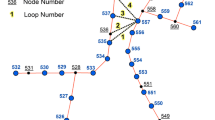Abstract
Three parameters were introduced here, in the second paper of the series, to evaluate layout structure of multi-quality water supply networks for irrigation. The first parameter was flexibility, which assesses the capability for a flexible supply of variable water quality values which can be obtained by dilution inside the network facilities. The second was separability which expresses the capability of the network to be divided into separate isolated sub-networks, each carrying a different water quality. The third was rigidity, which expresses a rigid allocation of one to one source–consumer connections. Five types of network layout which were presented in Sinai (2011) were evaluated here, using these three parameters. The flexibility of a network was given special attention with the example of parallel and serial connection of fields to sources. A real example of a proposed network in the Hazeva region in Israel was analyzed. All feasible flow patterns (FFPs) were computed. The location of mixing and dilution junctions and computation of the QC feasibility domains were found and computed for every junction and consumer. Relative ranges of discharges and concentrations were conducted for all the FFPs found. However, no single optimal FFP with maximal flexibility was found. Therefore the FFPs were arranged in operational groups for possible sequential operation according to irrigation schedules.





Similar content being viewed by others
References
Cohen D, Shamir U, Sinai G (2000a) Optimal operation of multi-quality water supply systems: I—Introduction and the Q-C Model. Eng Optim 32:549–584
Cohen D, Shamir U, Sinai G (2000b) Optimal operation of multi-quality water supply systems: III—The Q-C-H Model. Eng Optim 33:1–35
Cohen D, Shamir U, Sinai G (2004a) Water quality aspects of optimal operation of rural water distribution systems for supply of irrigation and drinking water. Irrigation and Drainage ICID 53:339–361
Cohen D, Shamir U, Sinai G (2004b) Sensitivity analysis of optimal irrigation supply systems with water quality considerations. Irrig Drain Syst 18:227–253
Dalins B (1986) Synthesis of the network graph in multiquality water systems. M.Sc. Thesis, Faculty of Agric. Engr., The Technion-IIT, Haifa, Israel (in Hebrew) 140 p
Ho CK, Orear L, Wright JI, McKenna SA (2006) Contaminant mixing in pipe joints: Comparison between laboratory flow experiment and computational flow dynamic model. in proceedings of the 8th Annual Water Distribution Systems Analysis Symposium, Cincinnati, OH. Aug. 27, 2006
Ostfeld A (2005) Optimal design and operation of multi-quality networks under unsteady conditions. J Water Resour Plng Mngmt ASCE, 2005/1
Ostfeld A, Salomons E (2004) Optimal operation of multi-quality water distribution systems: unsteady conditions. Eng Optim 36(3):337–359
Percia C, Oron G, Mehrez A (1997) Optimal operation of regional system with diverse water quality sources. J Water Resour Plng Mgmt ASCE 123(2):105–115
Rossman LA (2000) EPANET2—user manual. Water supply and Water Resources Div., National Risk Management Research Lab. EPA, Cincinnati, OH, USA
Sinai G (2011) Layout structure of multi-quality irrigation networks: I—Introduction and layout types. Irrigation and Drainage Systems. doi:10.1007/s10795-011-9109-y
Sinai G, Dalins B-Z (2007) Design of irrigation water supply systems using the Q-C feasibility domain concept: II. Effect of layout and applications. Irrigation and Drainage ICID (accepted)
Sinai G, Dalins B-Z (2011) Layout structure of multi-quality irrigation networks: III—Comparison of dilution and separate networks. Irrigation and Drainage Systems (accepted).
Sinai G, Dalins B-Z, Cohen D, Shamir U (2007) Design of irrigation water supply systems using the Q-C feasibility domain concept: I. Introduction and theory, Irrigation and Drainage ICID (accepted)
Acknowledgement
Thanks are expressed to Mrs. Sally Kaplan and Mrs. Ruth Adoni, for editing and to Mr. Arieh Aines for graphics.
Author information
Authors and Affiliations
Corresponding author
Rights and permissions
About this article
Cite this article
Sinai, G. Layout structure of multi-quality irrigation networks: II—flexibility, separability and rigidity of networks. Irrig Drainage Syst 25, 197–214 (2011). https://doi.org/10.1007/s10795-011-9110-5
Published:
Issue Date:
DOI: https://doi.org/10.1007/s10795-011-9110-5




